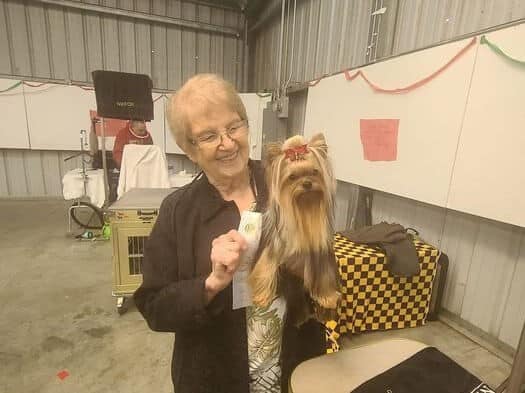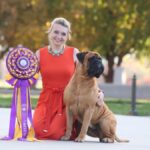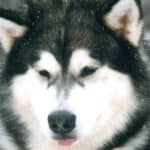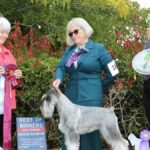Interview with Sharon McCadam, Breeder of FirAcres Yorkshire Terriers
Where do I live? How many years in dogs? How many years as a breeder?
Sharon McCadam: We are located in Mount Vernon, Washington, Gateway to the San Juan Islands and upper Puget Sound, 60 miles north of Seattle and 60 miles south of Vancouver, BC, Canada!
I attended my first dog show in 1960 on our honeymoon. My husband’s sister was showing Afghan Hounds at the Seattle Kennel Club event the day after our wedding, so we stopped on our way to Vancouver BC to watch her show her entry. SKC was still a benched show, held in the National Guard Armory. I was enamored, hooked on this activity, and the rest is history with the purchase of our first show prospect, a Norwegian Elkhound, CH Windy Coves Jock O Lantern, who finished his Championship handily. Our first Yorkshire Terrier was purchased in 1972 for our daughter, Kari, as a Juniors Dog. We have shown and finished breeds in German Shorthaired Pointers, Pointers, Norwegian Elkhounds, Miniature Poodles, and Chinese Cresteds over the past 60 years, but the Yorkshire Terrier won out as the “winner” because of the challenge the breed presented—to me especially.
I have been a breeder for 55 years, since our first litter of Elkhound puppies.
What is my kennel name? How many dogs do I currently keep?
Sharon McCadam: We started with Shedaron, which was often mis-pronounced, and we changed to FirAcres in 1967 due to the property where we lived being populated with Fir trees. An interesting side note: it too is often misread as Fire Acres!
Between retired Champions and those currently in the ring, we keep 20 Yorkies. Our oldest is our GCH FirAcres Hey Now, You’re An All Star, “Teebo,” 11-1/2 years young. Many of our retired girls are placed in forever homes; the boys stay with us.
Which show dogs from the past have been my noteworthy winners?
Sharon McCadam: The campaigning of our Champions was never a goal or burning desire on my part. I truly am a “newbie” in the campaigning of a Special, finishing 2022 with “Newman,” GCHS FirAcres The Hustler, as No. 5 Breed and No. 2 All-Breed Yorkie, followed this year by “Shooter,” GCHB FirAcres Give It Your Best Shot, currently No. 2 Breed and All-Breed (statistics to 5/31/2023).
Which have been my most influential sires and dams?
Sharon McCadam: The study of the pedigrees of our current Yorkies notably includes: Mayfair Barban, Yorkboro, Pastoral, Clarkwyn, This Time, and the foundation dogs behind those breeders’ kennels whom I had the good fortune to be “hands-on familiar” with many of the dogs within those lines. I rely a good deal on combining and stacking the gene pools that have produced our current Yorkies that we are showing and breeding.
Can I talk a bit about my facilities? Where are my puppies whelped? How are they raised?
Sharon McCadam: Our dogs are housed within our home, with our kennel population in the adjoining finished garage right off the kitchen. Current show dogs live individually in pens with satin crate pads when not in the kennel runs exercising. I have wooden deck runs as well as concrete pads with cyclone runs, which are visible through the kitchen window, as well as onto the patio area for the “cut-downs.”
Our puppies are whelped by my bed in a raised 2×3 and kept in the bedroom until their eyes open, and then they are moved into our living room/dining/kitchen area to become familiar with house sounds, television on all day, and have playtime when old enough on the floor, and weather permitting, out in the front puppy playpen area after their first vaccinations. They experience street sounds and people walking by, never without supervision. I start hand-stacking as they have toenails and ears trimmed at 3 weeks on. As the puppies age, they are handled and talked to often. They interact with our cats with their moms’ supervising, underfoot, with us doing the puppy shuffle when they are running loose.
What is my “process” for selecting Show Puppies? Performance Puppies?
Sharon McCadam: First, testicles, spectacles, and bites!!! Weight at 8 weeks, triple that weight, 12 weeks, double that weight for expected adult weight, and hopefully, at least 5 pounds but not over 7 pounds as adults, as our Yorkie Breed Standard states.
I look for the attitude of “Look at Me” and a natural stance, not needing a lot of adjustment when hand-stacking. I am happy with a puppy who lands 4-square. Level back, with neck indicating shoulder layback and humerus for a front to come straight at me, rear not over-angulated, reach and drive movement with command of themselves, tail naturally up most (or all) of the time at 11 to 1 o’clock! Eyes not round and prominent, muzzle not too short and skull not too rounded. Skull should be fairly flat with, hopefully, small ears held high. Coat texture, color, and not clearing too early to dark blue. I love a dark silk on a dog that does not break to blue till at least a year or more of age, indicating holding the dark blue as a mature dog at two years and beyond.
I personally love watching Performance Sports and feel the Yorkie can excel in those events with the right handler/trainer; however, my heart and passion is in the Conformation ring and the whelping box. But I would suggest temperament, sturdiness, soundness, and being a puppy who responds quickly to your attention and is tuned into you would be a starting point in assessing that Performance prospect’s potential.
How important are Breed Specialties?
Sharon McCadam: I covet the many years I have attended Specialties in several areas of our country and in Canada (BC). Interacting one on one with other breeders, studying other exhibits, and discussions held among breeders is paramount in not succumbing to tunnel vision within your own dogs or within your circle of breeder-friends. I’ve often said, my greatest critics are on the outside of the ring looking in. I respect and expect their comments. And I have attended many other Breed Specialty events as well as studied other breeds being judged at dog shows, not just Toy breeds. Much can be learned by watching breeds other than your own.
We are fortunate in Yorkshire Terriers to have a nucleus of successful breeders within our borders who are also supportive and active in our 15 Regional Clubs in several different areas of the US. The opportunity for exposing our Breed has expanded, as these clubs may hold four local events, and a fifth if joining the breed’s National Event.
What are my priorities when it comes to breeding? What are the drawbacks?
Sharon McCadam: We must keep the written words within our Standard foremost when making breeding decisions. This breed is a TOY TERRIER. Structure, temperament, level backline, clean coming and going as well a self-perceived “I’m Important” purpose in attitude on the “go-around’” are of prime importance to me. A huge plus is an easily maintained, silk-textured, dark blue coat and shaded tan on a dog or bitch with the reflective metallic shine. The appealing expression of keen interest of his surroundings, with well-placed ears and a “no stone goes unnoticed” attitude is within the Yorkie’s nature. I strive for that picture.
As for drawbacks, you might guess, a “wussy.” An “I don’t want to be here” attitude is not a good candidate for breeding qualities. And the too short in muzzle, “round approaching apple head” with too round and prominent eyes is undesirable “type” and can contribute to incorrect dentition, including missing teeth and misalignment, open fontanels. This cannot comply to having a small head with a rather flat skull as our Standard states. The “cat-faced,” “baby-doll” head is not what our ideal head describes. It is far more important to address set-on of muzzle, high ear set, and a very aware expression that is desirable. I dislike the Yorkie becoming a “head breed.”
I’ve observed “one leg coming out behind” appearance and “all over the map” fronts with little to no reach and drive, leading to “movement all under themselves” becoming too often seen. Soundness in our breed can be an issue, with patella luxation a problem—not uncommon in many Toy Breeds. Early tooth loss is equally often found, thus, good-sized teeth in an adequate jaw are desirable. It goes without saying, toplines, tailset, and high head carriage are good attributes to seek; a chin held on the same level as the backline cannot create that picture regardless of the tight lead! The too light, non-reflective blue and non-shaded tan coat that is not cool to the touch is difficult to correct in a program. Better to cut your losses than to keep seeking correct coat texture and color. Always structure first.
How would I define “conditioning” as it relates to my breed? How important is coat care?
Sharon McCadam: Over the years, with my first Yorkies, my cupboards by the bathing area for the dogs have seen a plethora of promised “coat correcting” products! As time has come and gone, incorporating genes from other kennels, doing frequent baths and carefully brushing and wrapping coats, the fully coated dogs and youngsters in the wings will not grow a coat if each individual is not kept in pristine housing, on silk protective bedding. Paying attention to not over-zealous playing together will allow the coat to continue to grow to “show ring length.”
Always use a good moisturizing conditioner (not thoroughly rinsed out with cool water for maintenance) and if a coat wants to pack up, then some oil added to the diluted conditioner and left in before wrapping is helpful. Genetics does play a key role in attaining the coat length and texture that the Standard describes, which is, to me, the frosting on the cake.
Are there any health-related concerns in my breed? Any special nutritional needs?
Sharon McCadam: Patella Luxation, eye exams for PRA. I cannot state this any better than the YTCA Parent Club’s Health Statement.
After one year of age, OFA screenings are available for Patellas and PRA Eye Conditions. There are other conditions which may affect the breed such as Liver Shunt, Microvascular Dysplasia (MVD), Protein-Losing Enteropathy (PLE), Encephalitis, Degenerative Myelopathy (DM), and Hyperuricosuria.
As for nutritional needs, I look for dog food (kibble) with a high-calorie content per cup, as Yorkies, as a rule, are not gluttonous or overeaters. So, calorie density per cup goes into my purchase of kibble. I do add additional meat, but I am not a fan of raw feeding, as traveling to long show weekends limits the longevity of raw, even if leaving some frozen. The freeze-dried products available seem to be a safe alternative to kennel fare, as living in the Pacific Northwest and dealing with cold, damp weather during a good share of the year brings me to wanting the dogs to have a warm meal, especially after spending time outside in our cool climate for most of the year.
Do I think my breed is supported by a sufficient number of preservation breeders?
Sharon McCadam: Yes, at this time; however, as we become aware of the dog fancy’s population throughout the world, many of our preservation breeders are a graying society. I find today’s Yorkie enthusiasts are not looking so much to work and study to develop a breeding line and carry on the work of those of us who are aging out of this hobby, but are instead wanting to purchase that outstanding show prospect that might be available, have their day in the sun, and move on to their next dog or even breed.
Is my breed well suited to be a family dog? Who are the best candidates to own my breed?
Sharon McCadam: Each family that approaches me has their own unique ideas and expectations for their new family member, and those ideas really need to be talked through with them. I am reluctant to place a 12-16-week-old puppy in a family with toddlers, although there are those families that are exceptions to this rule.
Children aged 8-9 years and older seem to be my rule of thumb; on the other hand, when approached by a family wishing to have a Yorkie join an elderly person’s home for a companion, I have to address that Yorkies can live to 15 years or more. Add that age to the recipient’s current age, with the knowledge they may not outlive the dog and plans must be understood and in place for the dog’s well-being should the need arise. My conditional contract does state that my responsibility to that puppy or retiring adult being placed is “from womb to tomb” and an agreement must be signed and in place before placement.
What is the biggest misconception about my breed? What is my breed’s best-kept secret?
Sharon McCadam: The Yorkshire Terrier is first a DOG! Not a child with four legs—they know how to use them! The prospective new home may have been acquainted with an older Yorkie that made them believe they must have one, but WHOA! “What is this spitfire of a puppy that has graced my home?!”
As Yorkies age, as in most breeds, they become more sedentary and sleep more, but a youngster must have direction and supervisiofn. I have said it often, they are like living with a toddler. Remind them and repeat till they get it right: Potty Time, Quiet, and Wait when the door opens, etc. I have found the husbands in a family are sometimes resistant to that LITTLE dog coming into their lives, so be careful, as the Yorkie figures out real quickly who they need to bring under their spell, which may lead to the second purchase as the first Yorkie becomes the husband’s dog!
If I could share a comment or two with judges of my breed, what would I like to say to them?
Sharon McCadam: The operative word is in the breed’s name: Yorkshire Terrier. They were created in the beginning to be ratters and that attitude is so important to reward. They are not statues or lazy little lap dogs when out and about strutting their wares! The reflective light pattern on their body as they gait into your ring will give you a pretty accurate idea of what your hands will find on the exam table. The often-heard reference, “big dog in a small body,” is so descriptive of this true Toy Terrier, and dark steel blue just breaking at 18 months or so is this breeder’s “hurrah!” He/She will have correct color as a veteran!
Do I have any words of wisdom to pass along to newer breeders?
Sharon McCadam: I think we all hope for success for the new Yorkie fancier who will eventually want to breed their show dog and follow in their breeder/mentor’s examples. Often, we are approached only wanting a female show prospect with breeding as a goal; however, I would encourage new exhibitors to the breed to “cut your teeth” and purchase a male as your first show puppy.
Not necessarily that you will use that dog as your stud down the road, but as a neophyte in a breed you need to learn, practice, and hone your skills on that first show pup. And if for some reason (or many) he does not pan out to be successful, you will have learned a good deal about the breed. He can be neutered and will be a fabulous companion, because if I had a choice my breeding program would only be the boys! Bitches are called bitches for very good reasons. Universally, by nature, boys will do all they can to garner your favor. Girls, well, maybe, if it suits them, but then, maybe not!
For a bit of fun, what’s the most amusing thing I’ve ever experienced with a Toy Dog?
Sharon McCadam: While on vacation years ago with one of our first Yorkie Champions, we were enjoying Lake Crescent with “Sparkle” where a mother duck and her brood were so enticing. Sparkle waded in to investigate. Momma duck, being a clever duck, kept swimming in towards her and then into deeper waters, along with her brood, and it became apparent that enticing the “predator” into deeper water would soon find Sparkle in trouble. Sparkle would either have had to give up or not make it back to shore, but fortunately, she was very responsive to being called back to safety. I found it a good study of Mother Nature and instincts instilled in her creatures.








